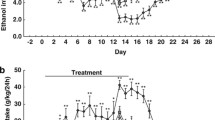Activity of hemantane, an amino adamantane derivative, exhibiting the properties of lowaffinity non-competitive NMDA receptor antagonist, was evaluated in experimental in vivo models of alcoholism. Hemantane had no effects on the formation and manifestation of behavioral sensitization to ethanol in DBA/2 mice. Under conditions of free choice between 10% ethanol and water, hemantane (20 mg/kg/day for 14 days, intraperitoneally) significantly reduced the daily ethanol intake in random-bred male rats with formed alcohol motivation (>4 g/kg of ethanol). During modelling of withdrawal syndrome, hemantane administered intraperitoneally in doses of 5-20 mg/kg dose-dependently attenuated alcohol-deprivation effect after acute withdrawal with no effects on protracted abstinence. It was found that hemantane suppressed alcohol drinking behavior in long-term ethanol experienced rats and attenuated alcohol-seeking behavior after acute withdrawal.
Similar content being viewed by others
References
Abaimov DA, Zenina-Antipova TA, Kovalev GI, Seredenin SB. Effect of antiparkinsonian drug himantane on the content of dopamine transporter DAT protein in rat striatum and cultured pheochromocytoma PC-12 cells. Bull. Exp. Biol. Med. 2008;145(3):331-333.
Elshanskaya MV, Sobolevskii AI, Khodorov BI, Val’dman EA. Interaction of the new adamantane derivative A-7 — a potential antiparkinsonian drug — with NMDA receptor channels. Eksp. Klin. Farmakol. 2001;64(1):18-21. Russian.
Katunina EA, Petrukhova AV, Avakyan GN, Valdman EA, Nerobkova LN, Voronina TA, Sayadyan KhS. The possibilities of using himantane in the treatment of Parkinson’s disease. Zh. Nevrol. Psikhiatr. 2008;108(6):24-27. Russian.
Kolik LG, Nadorova AV, Val’dman EA, Seredenin SB. Peculiarities of the Effect of Aminoadamantane Derivatives on Ethanol-Induced Ataxia, Sedation, and Hyperlocomotion in Mice. Eksp. Klin. Farmakol. 2016;79(10):8-12. Russian.
Kolik LG, Nadorova AV, Seredenin SB. Selank Inhibits Ethanol-Induced Hyperlocomotion and Manifestation of Behavioral Sensitization in DBA/2 Mice. Bull. Exp. Biol. Med. 2016;162(1):56-59.
Alaux-Cantin S, Buttolo R, Houchi H, Jeanblanc J, Naassila M. Memantine reduces alcohol drinking but not relapse in alcohol-dependent rats. Addict. Biol. 2015;20(5):890-901.
Evans SM, Levin FR, Brooks DJ, Garawi F. A pilot doubleblind treatment trial of memantine for alcohol dependence. Alcohol. Clin. Exp. Res. 2007;31(5):775-782.
Holmes A, Spanagel R, Krystal JH. Glutamatergic targets for new alcohol medications. Psychopharmacology (Berl). 2013;229(3):539-554.
Jamadar S, DeVito EE, Jiantonio RE, Meda SA, Stevens MC, Potenza MN, Krystal JH, Pearlson GD. Memantine, an NMDA receptor antagonist, differentially influences Go/No-Go performance and fMRI activity in individuals with and without a family history of alcoholism. Psychopharmacology (Berl). 2012;222(1):129-140.
Jeanblanc J, Coune F, Botia B, Naassila M. Brain-derived neurotrophic factor mediates the suppression of alcohol selfadministration by memantine. Addict. Biol. 2014;19(5):758-769.
Kotlinska J, Bochenski M, Danysz W. N-methyl-D-aspartate and group I metabotropic glutamate receptors are involved in the expression of ethanol-induced sensitization in mice. Behav. Pharmacol. 2006;17(1):1-8.
Krystal JH, Petrakis IL, Limoncelli D, Webb E, Gueorgueva R, D’Souza DC, Boutros NN, Trevisan L, Charney DS. Altered NMDA glutamate receptor antagonist response in recovering ethanol-dependent patients. Neuropsychopharmacology. 2003;28(11):2020-2028.
Madara JC, Levine ES. Presynaptic and postsynaptic NMDA receptors mediate distinct effects of brain-derived neurotrophic factor on synaptic transmission. J. Neurophysiol. 2008;100(6):3175-3184.
Morice E, Denis C, Giros B, Nosten-Bertrand M. Evidence of long-term expression of behavioral sensitization to both cocaine and ethanol in dopamine transporter knockout mice. Psychopharmacology (Berl). 2010;208(1):57-66.
Spanagel R. Alcoholism: a systems approach from molecular physiology to addictive behavior. Physiol. Rev. 2009;89(2):649-705.
Author information
Authors and Affiliations
Corresponding author
Additional information
Translated from Byulleten’ Eksperimental’noi Biologii i Meditsiny, Vol. 164, No. 8, pp. 177-183, August, 2017
Rights and permissions
About this article
Cite this article
Kolik, L.G., Nadorova, A.V. & Seredenin, S.B. Non-Competitive NMDA Receptor Antagonist Hemantane Reduces Ethanol Consumption in Long-Term Alcohol Experienced Rats. Bull Exp Biol Med 164, 152–157 (2017). https://doi.org/10.1007/s10517-017-3946-0
Received:
Published:
Issue Date:
DOI: https://doi.org/10.1007/s10517-017-3946-0




